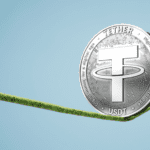What if I told you that you could own a digital currency with all the uncertainties of crypto longevity, but it’s in a centralized treasury, pegged to the inflating value of fiat, AND taunting governments into considering digital fiat!
Wow, you might think that’s a lose-lose-lose proposition…
But wait a minute, don’t hate on stablecoins quite so fast (or do). Maybe they actually serve some purpose in the crypto market. Let’s discuss.
What even are stablecoins?
Before you can decide how useful they are, you probably want to understand exactly what stablecoins are.

Cryptocurrencies, as we all know, are extremely volatile. Stablecoins are just what they sound like—digital currencies that try to maintain a stable value. While the price of Doge, Shiba Inu, and even Bitcoin swing wildly all over the place, stablecoins are pegged to the value of another asset, which allows them to sit comfortably at a consistent value.
Stablecoins can be pegged to the value of fiat currencies like USD, precious metals like gold, or even a basket of other cryptocurrencies. There are also some algorithmically stabilized currencies. The overall goal, however, is to maintain the benefits of crypto, like blockchain and peer-to-peer digital transactions, without the added risk of crazy volatility.
Popular stablecoins
There are quite a few stablecoins that have gained popularity, especially as DeFi has boomed in the last couple of years—more on that later. Here are a few examples:
Tether (USDT) is the most used stablecoin and has the highest market cap—around $110 billion at the time of this writing—and is pegged to the value of USD at a 1:1 ratio.
USD Coin (USDC) is the number two stablecoin. Created by Coinbase, it can be exchanged with USD for free on the Coinbase exchange. It’s an ERC-20 and can be used on Ethereum.
Binance (BUSD) can also be used on Ethereum. It was launched by the Binance exchange and has no fees on that exchange for BUSD trading pairs.
Dai (DAI) is a crypto-backed stablecoin that uses Ethereum assets to stabilize the price. Because crypto is volatile, a 1:1 ratio is too risky, so assets are overcollateralized.
Frax (FRAX) is an algorithmically stabilized coin that expands and contracts the supply, like a central bank, to stabilize the price. It’s collateralized with other stablecoins such as USDC.
PAX Gold (PAXG) is pegged to the value of gold and can be redeemed for 1 troy ounce of gold held in the Paxos vaults or gold bullion bars. It’s an ERC-20 token used on Ethereum.
Do stablecoins have a use?
 There are a lot more weeds to get into when it comes to how stablecoins work.
There are a lot more weeds to get into when it comes to how stablecoins work.
But for now, we’re just talking about the overview of their purpose and utility. If you want to combat your insomnia, feel free to dive deep into the technicalities. In the meantime, we’ve saved you the trouble of going down the research rabbit hole and organized this handy list of a few use cases for stablecoins.
Holding liquidity without exiting crypto
One reason many people hold stablecoins is to have some liquidity without completely trading out of cryptocurrency. For example, if you want to get out of some risky and volatile trading positions, but you don’t want to completely convert your asset back to fiat, you could hold a stablecoin—in some cases, you must use a stablecoin to trade on an exchange. While you will still be taxed if you trade profits into a stablecoin, there are often more regulations, delays, and fees converting back fiat.
DeFi lending
A really popular use that has emerged for stablecoins is in DeFi. Yield farming, liquidity pools, and staking are more predictable and profitable when your collateral has a consistent value. If the value of your asset is moving around too much, like cryptocurrency usually does, you can quickly lose profits on a trading pair. DeFi has become one of the biggest uses of stablecoins and has done a lot to drive crypto adoption, putting people at ease about exit strategies for risky investments.
Transferring fiat value without transferring fiat
Another good use for stablecoins is making payments between businesses or people who want to transfer funds, but don’t want to use fiat. If someone pays you in BTC, for example, the value of your time, product, or service may be wildly different tomorrow than it was the day you got paid. Or, let’s say you want to get paid by someone in another country. Exchanging fiat currencies can cost unnecessary exchange fees that peer-to-peer payments with stablecoins eliminate.
Why people hate stablecoins
 Ok, maybe this was a bit extreme…I don’t know if it’s completely accurate to say that people hate stablecoins. Maybe Bitcoin maximalists do—but does everyone?
Ok, maybe this was a bit extreme…I don’t know if it’s completely accurate to say that people hate stablecoins. Maybe Bitcoin maximalists do—but does everyone?
The fact is, plenty of people hold stablecoins. And because DeFi has become such a key sector in crypto, stablecoins are gaining more and more use cases. There are certainly some criticisms to be had, however. Here’s a list of the top reasons why some people love to hate stablecoins.
Volatility gets gains
While yield farming is a growing use for stablecoins, it can be complicated and not everyone is bold enough to make use of DeFi on that level. Buying the dip, however, is what everyone knows about and #ToTheMoon is everyone’s goal. If you want those insane profits, volatility is a friend, not a foe.
Backed by worse-than-fiat
If you thought that a cryptocurrency backed by fiat was bad, hold onto your hat. Back in 2021, Tether, which used to claim it had 100% reserves in USD, was fined $41 million when the Commodity Futures Trading Commission (CFTC) found out that only 2.9% of Tether’s reserves were cash. The rest was commercial paper (corporate debt).
Hold fiat if you want stability
There are still lots of issues plaguing stablecoins like questionable underlying assets, having their value peg broken, getting smacked around by governments and regulators, centralized structures, and sometimes having questionable development teams. If all of this is the case, why not just hold fiat if you want stability? Sure, fiat is worth its weight in trash, but when stablecoins are backed by other stablecoins that are backed by fiat, which is backed by debt anyway, it’s all just layers of lipstick on a pig.
Regulation
In the US, regulators are currently trying to find ways to rein in the “out of control” crypto space so the government can not only get its cut, but retain its monetary sovereignty. Bitcoin is extremely difficult to regulate because it escapes one criterion of the Howey test that determines whether the SEC can regulate an asset. Stablecoins, on the other hand, are squarely in the sights of the SEC and the CFTC. They are a perfect entering wedge for cracking down on crypto because they often operate in a similar way to banks and thus, can be regulated as such. As capital pours out of traditional financial services into the unregulated world of DeFi, the powers that be are not pleased.
Fed chairman Jermone Powell implied in the summer of 2021 that central banks would love to choke out the use of cryptocurrency when he said, “You wouldn’t need stablecoins; you wouldn’t need cryptocurrencies, if you had a digital U.S. currency.” It should come as no surprise that today, most central banks are working on CBDC projects.
While, on one hand, stablecoins have helped drive crypto adoption by making retail investors a little more comfortable with the value of their crypto investments, that adoption explosion also seems to be waking up institutions and banks to the reality that if they don’t change the rules, they’ll lose the game.
Conclusion
Stablecoins may be a useful thing in the current crypto and DeFi ecosystems but there’s a reason people don’t like them—they’re about as close to digital fiat as you can get without being digital fiat.
In some ways, they’re the worst of both worlds—backed by assets which themselves have questionable value and tripping over problems that all technologies in their infancy face. Depending on what your crypto strategy is and how you plan to invest your wealth, stablecoins might be a necessity in your wallet. But, as the cryptosphere continues to move forward, there could be a battle coming among governments, centralized companies, and crypto enthusiasts.
The questions remain:
Which forms of money will win out? What do you think the fate of stablecoins will be? Can they survive the coming regulation-pocalypse and stand up to the possibility of digital fiat?
About the Author

Michael Hearne
About Decentral Publishing
Decentral Publishing is dedicated to producing content through our blog, eBooks, and docu-series to help our readers deepen their knowledge of cryptocurrency and related topics. Do you have a fresh perspective or any other topics worth discussing? Keep the conversation going with us online at: Facebook, Twitter, Instagram, and LinkedIn.


